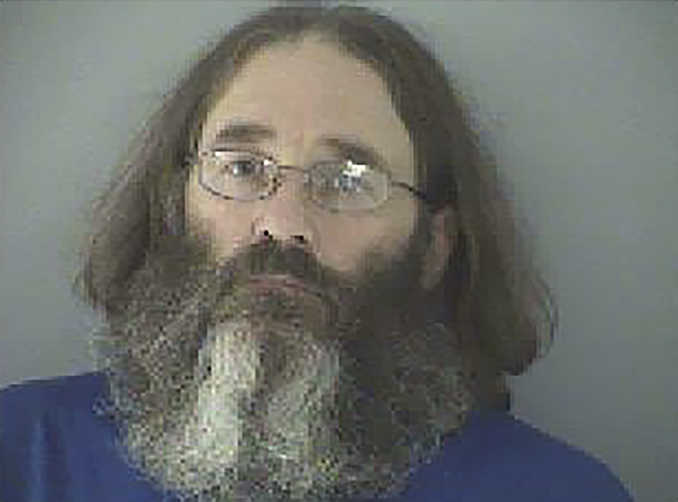CINCINNATI — He was known as “Bismarck,” a genial, thick-bearded hiker who had become a familiar character along the Appalachian Trail over the past six years, and a regular at Susie Montgomery’s bed-and-breakfast in a small Virginia town — until the day the FBI showed up.
“I’d say he was one of my favorite guests,” said Montgomery, whose Montgomery Homestead Inn offers on its website a place to “forget life’s stresses” for a slower, simpler life. “He was a smart man, interesting to talk to; a pleasant personality. All of the other people who stayed here liked him.”
He was in his room, she recalled, on May 16 during the annual Trail Days festival that brings thousands of people into tiny Damascus, Virginia, when she responded to a knock on the door. She recounted finding three agents, one holding up a picture of Bismarck. He told her they believed her guest was someone the FBI wanted, she said. Her husband spotted someone guarding the back door.
Soon Bismarck was being led away in handcuffs, and the FBI was announcing the arrest of James T. Hammes, a white-collar crime suspect missing since 2009.
“They allowed me to hug him,” she said. “He whispered to me that he was sorry that this happened.”
The 53-year-old Lexington, Kentucky, accountant now sits in a southwest Ohio county jail. He has pleaded not guilty and is scheduled for trial next month in U.S. District Court in Cincinnati on charges that he embezzled nearly $9 million from his Ohio-based employer, an indictment handed up after he had already disappeared, apparently into the 2,200-mile trail stretching from Georgia to Maine.
Authorities aren’t saying much about what they believe happened to the money or Hammes’ whereabouts the past six years. “It’s still an ongoing investigation,” FBI spokesman Todd Lindgren said.
But Hammes seems to have been hiding in plain sight much of the time since he bolted soon after being questioned about the missing millions.
“I think the most surprising thing about it to me is he had high visibility on the Appalachian Trail,” said David Miller who writes a guidebook called The A.T. Guide and chronicled his own journey in a book, “AWOL on the Appalachian Trail.”
Miller knew about Bismarck, who showed up in photos in hikers’ journals and sent Miller notes for his guidebook updates, such as whether a hotel was giving hikers special rates. Hikers posted on social media selfies with Bismarck; one shows a laughing Bismarck in a water gun battle.
“He was a little more gregarious and social than the typical hiker,” said Miller, who said Bismarck stopped by his booth to chat at the annual Trail Days festival the day before Hammes’ arrest.
Hikers often adopt “trail names” to be known as during their Trail adventures. The significance of the Bismarck name isn’t clear; Hammes is a Milwaukee, Wisconsin, native who was living in Kentucky. During hiker small talk, Bismarck is said to have sometimes told people he had a software company.
Hammes, also a licensed pilot, had credited successful investment in a software company for extra money that paid for scuba diving trips to the Caribbean in the years before his indictment, according to former in-laws who were interviewed for an episode of the CNBC series “American Greed.” A fellow hiker has been credited with recognizing Bismarck from the show, leading to Hammes’ eventual arrest.
Hammes was Lexington-based controller for the southern division of G&J Pepsi-Cola bottlers. Called by company officials to Cincinnati headquarters in February 2009, he was confronted about missing funds investigators say topped $8.7 million. Authorities say Hammes soon disappeared, leaving behind a wife who would later divorce him and his daughter.
FBI special agent Pamela Matson stated in an affidavit that G&J funds were deposited into an unauthorized account that played off the name of a vendor. Investigators found that Hammes opened the account in 1998, she said. He repeatedly wrote checks to the sham vendor account, then quickly moved the deposits into his own bank account, according to Matson.
Accounts have placed Hammes staying in Maine and northern Indiana when not on the Trail during his time on the lam, although the FBI wouldn’t discuss its own findings.
Miller, who is Hammes’ age, left his job as software engineer more than a decade ago to hike the Trail. He suggested that while the popular Trail might seem an odd place for a fugitive to show up repeatedly, being Bismarck could have given Hammes a feeling of belonging to something during his life as a fugitive.
“You could speculate that in his situation, he was feeling isolated,” Miller said, “and this let him establish some sense of community.”
___
AP News Researcher Rhonda Shafner in New York contributed to this report. Contact the reporter at http://www.twitter.cm/dansewell

